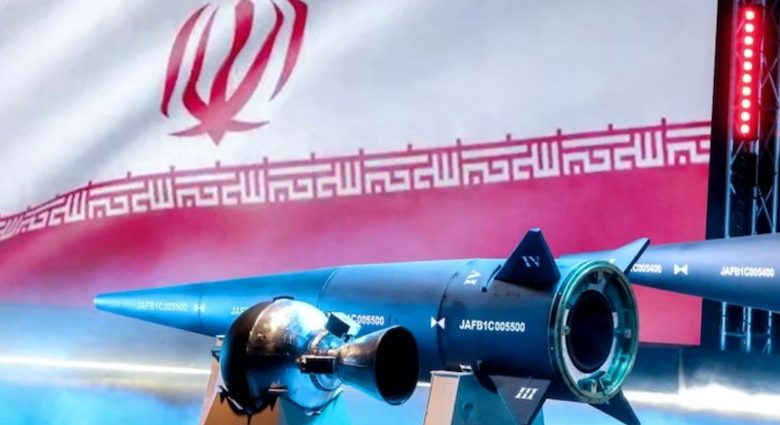Israel has unveiled a hypersonic missile interceptor concept, a pioneering bid to toughen its defenses against Iran’s reputed hypersonic threat and win access to emerging European and US counter-hypersonic defense markets.
Breaking Defense reported this month that Israel’s Rafael Advanced Defense Systems unveiled its Sky Sonic hypersonic interceptor missile at the Paris Air Show, with an eye toward securing European missile defense contracts.
The report notes that Sky Sonic, which has been under development for several years and not been tested, uses hit-to-kill technology and is designed with open architecture for maximum flexibility.
It also mentions that Rafael has presented the project to the US, with the latter apparently giving positive feedback.
In a company statement, Rafael said, “Successful defense against hypersonic threats requires a multifaceted approach that involves not only countering their speed but also effectively tracking, detecting and intercepting their unpredictable flight paths.”
The pressure on Israel to develop counter-hypersonic defenses has likely become more urgent as its arch-rival Iran has claimed to have developed a hypersonic weapon.
This month, Asia Times reported that Iran publicly revealed its first hypersonic missile, the “Fattah,” or “opener” in Farsi. Iranian state media showcased what appears to be a maneuverable re-entry vehicle mounted on a ballistic missile body.
Iranian state media also claimed that the Fattah could travel at up to Mach 15, has a 1,400-kilometer range, uses solid propellant technology and has a moveable nozzle for high maneuverability.

However, there is cause to doubt Iran’s hypersonic claims, as the Islamic Republic is known to exaggerate its military capabilities for propaganda purposes. For one, current hypersonic missile technology supports designs flying up to Mach 5-6, so Iran’s claims of Mach 15 would appear to be an exaggeration.
Further, established hypersonic technology pioneers such as China, Russia and the US, all with greater resources and expertise than Iran, have faced various difficulties in their hypersonic weapons programs, casting more doubt on Iran’s claim.
Israel isn’t taking any chances. Besides its planned Sky Sonic hypersonic missile interceptor, Israel is also investing in alternative missile defense systems including the use of lasers.
Lasers have several advantages over missile-based defense systems, namely instantaneous hits, low cost per shot and scalable power. However, they face drawbacks such as huge power requirements, decreasing power over distance and sensitivity to atmospheric conditions.
Asia Times reported in February 2022 that Israel plans to build a “laser wall” in its southern regions to defend against missiles, rockets, drones and other long-range threats from Iran and its proxies.
In 2014, Israel unveiled its Iron Dome missile defense laser. However, at the time, Israeli officials concluded that the technology was not yet mature, with its limited range meaning it could not replace missile-based defenses but could be effective against very short-range targets.
Despite that setback, lasers might be the future of missile defense. Asia Times noted in May 2022 that future missile defense concepts might emphasize terminal point defense rather than wide area coverage.
While global and regional missile-based defense systems won’t become obsolete overnight, they can be complemented by numerous directed-energy weapons such as lasers to destroy rockets, missiles, loitering munitions and possibly hypersonic weapons in their terminal stages of flight.
However, as missiles destroy their targets instantaneously on impact, a laser must be focused on the target for a few seconds to destroy it, which may not be feasible for hypersonic targets moving at Mach 5 or faster.
Despite Israel’s missile defense prowess, it faces larger systemic challenges such as disjointed systems, limited capacity against a saturation attack and a tendency to incentivize military rather than diplomatic solutions.
In a May 2023 interview for the Center of Strategic and International Studies (CSIS), Moshe Patel, director of the Israel Missile Defense Organization (IMDO), noted that the biggest challenge for Israel’s missile defense is to integrate diverse systems to intercept a variety of airborne and ballistic threats.
Asia Times noted in May 2023 that disjointed air and missile defense systems might not be effective against an adversary deploying a wide array of improvised and advanced armaments such as homemade rockets, suicide drones, ballistic missiles, cruise missiles and even hypersonic weapons.
Unlinked air and missile defense systems are a recipe for failure against an adversary with a diverse arsenal.
No missile defense system is 100% foolproof, and Israel’s famous Iron Dome is no exception. In a May 2021 Forbes article, David Hambling notes that the Iron Dome has a high but unknown “saturation point” – the maximum number of rockets it can handle at a time. Hambling notes that excess rockets will get through once that unknown limit is exceeded.

Hambling also notes the disproportionate cost between the Iron Dome’s finite supply of Tamir interceptors, which cost US$50,000 per round versus $500 to $1,000 for Hamas and Hezbollah’s homemade rockets, and $20,000 for Iran’s Shahed loitering munitions.
Hambling also notes that the high effectiveness of missile defense systems may be a strategic liability, as missile attacks on Israel inflict relatively minor damage, often making Israel’s military responses seem heavy-handed and disproportionate to international observers.
He notes that Israel’s overreliance on its missile defenses such as Iron Dome, David’s Sling and, in the future, Sky Sonic means that their failure could be perceived as a dereliction of duty by the Israeli government to defend its people.
That potential failure could force the Israeli government to launch large-scale military offensives to take out enemy missile and drone launch sites or even dare pre-emptive strikes on Iran, with potential serious implications for escalation as Tehran pursues a nuclear bomb.

